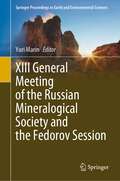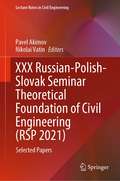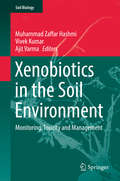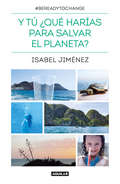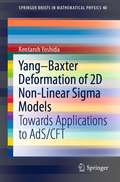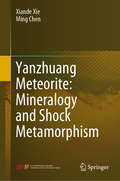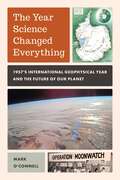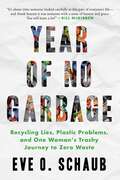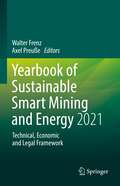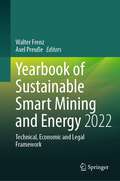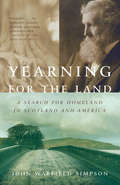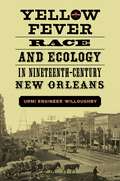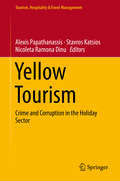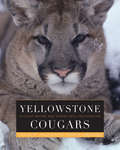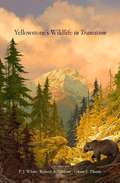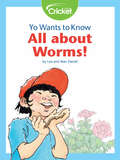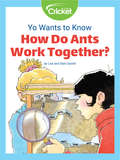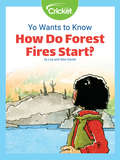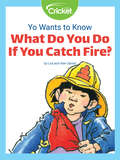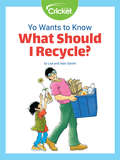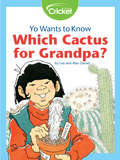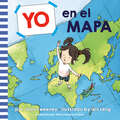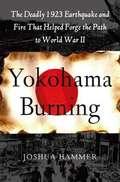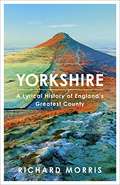- Table View
- List View
XIII General Meeting of the Russian Mineralogical Society and the Fedorov Session (Springer Proceedings in Earth and Environmental Sciences)
by Yuri MarinThis book presents the materials of the XIII General Meeting of the Russian Mineralogical Society. Over 190 participants prepared the result of their scientific work on mineralogy: mineral diversity and the evolution of mineral formation (S1); minerals as markers of petro- and ore genesis and new methods of their determination (S2); mineralogy and formation conditions of deposits of strategic minerals (S3); problems of applied (technological and ecological) mineralogy and geochemistry (S4); natural stone in art and architecture (S5); modern research in the field of stone and gemological studies (S6); mineralogical crystallography, crystallochemistry, and new minerals (F1); history of science, museumification, and popularization of natural science knowledge (F2). The Russian Mineralogical Society is the oldest mineralogical Society in Russia (from 1817). The Russian Mineralogical Society joins more than 1200 researchers from universities, academic and industry institutes, and production organizations in Russia's major scientific centers. The Society has 17 sections, including crystallochemistry, radiography and spectroscopy of minerals, ore mineralogy, technological mineralogy, experimental mineralogy, ecological mineralogy and geochemistry, and new mineral nomenclature classification. The main scientific and organizing event for the Russian Mineralogical members is the meeting session, organized every fourth year.
XXX Russian-Polish-Slovak Seminar Theoretical Foundation of Civil Engineering: Selected Papers (Lecture Notes in Civil Engineering #189)
by Pavel Akimov Nikolai VatinThis book gathers the latest advances, innovations, and applications in the field of civil, environmental and construction engineering, as presented by researchers and engineers at the XXX Annual Russian-Polish-Slovak Seminar Theoretical Foundation of Civil Engineering (RSP), held in September 2021. Co-organized by six universities from Russia, Poland and Slovakia, the event covered diverse topics such as structural mechanics; building structures; geodesy and geotechnics; transport and environmental issues in civil engineering. The contributions, which were selected by means of a rigorous international peer-review process, highlight numerous exciting ideas that will spur novel research directions and foster multidisciplinary collaborations.
Xenobiotics in the Soil Environment
by Ajit Varma Muhammad Zaffar Hashmi Vivek KumarThis book describes the vast variety of xenobiotics, such as pesticides, antibiotics, antibiotic resistance genes, agrochemicals and other pollutants, their interactions with the soil environment, and the currently available strategies and techniques for soil decontamination and bioremediation. Topics covered include: transport mechanisms of pollutants along the Himalayas; use of earthworms in biomonitoring; metagenomic strategies for assessing contaminated sites; xenobiotics in the food chain; phyto-chemical remediation; biodegradation by fungi; and the use of enzymes and potential microbes in biotransformation. Accordingly, the book offers a valuable guide for scientists in the fields of environmental ecology, soil and food sciences, agriculture, and applied microbiology.
Y tú ¿qué harías para salvar el planeta?
by Isabel JiménezUn ensayo periodístico comprometido y valiente que aporta alternativas y soluciones a la contaminación producidad por el plástico. «No se trata de volver al pasado, se trata de buscar un futuro en el que tenga cabida el progreso, pero con soluciones sostenibles a los residuos. Apostemos por el consumo responsable», escribe Isabel Jiménez en Y tú ¿qué harías para salvar el planeta? Uno de los rostros más respetados de la televisión muestra su compromiso con la sostenibilidad y el medioambiente en un tema que exige soluciones ya: la reducción del consumo de plástico. El futuro del planeta está en nuestras manos, y la solución al problema también. Hay esperanza: todavía estamos a tiempo para cambiar el futuro. Es posible un consumo responsable que permita una reducción drástica de los plásticos de un solo uso. Se puede caminar hacia un nuevo modelo de producción más acorde con la naturaleza. Es hora de apostar por la economía circular: «Hacer más con menos, reducir la materia prima y reutilizar». Y el compromiso es de todos: de los gobiernos, de los empresarios, de los activistas públicos, de los ciudadanos y del propio sector del plástico. En palabras de la autora: «A todos nos debería importar qué está pasando en los mares, en los ríos y en los océanos». Convirtámonos en la generación del cambio, salvemos el planeta. Y tú ¿qué harías para salvar el planeta? es un nuevo reto en la carrera profesional de la periodista Isabel Jiménez. En sus páginas muestra su compromiso con el medioambiente y deja el sello de su estilo: rigor informativo y cercanía para convertir en realidad un objetivo necesario.
Yang–Baxter Deformation of 2D Non-Linear Sigma Models: Towards Applications to AdS/CFT (SpringerBriefs in Mathematical Physics #40)
by Kentaroh YoshidaIn mathematical physics, one of the fascinating issues is the study of integrable systems. In particular, non-perturbative techniques that have been developed have triggered significant insight for real physics. There are basically two notions of integrability: classical integrability and quantum integrability. In this book, the focus is on the former, classical integrability. When the system has a finite number of degrees of freedom, it has been well captured by the Arnold–Liouville theorem. However, when the number of degrees of freedom is infinite, as in classical field theories, the integrable structure is enriched profoundly. In fact, the study of classically integrable field theories has a long history and various kinds of techniques, including the classical inverse scattering method, which have been developed so far. In previously published books, these techniques have been collected and well described and are easy to find in traditional, standard textbooks. One of the intriguing subjects in classically integrable systems is the investigation of deformations preserving integrability. Usually, it is not considered systematic to perform such a deformation, and one must study systems case by case and show the integrability of the deformed systems by constructing the associated Lax pair or action-angle variables. Recently, a new, systematic method to perform integrable deformations of 2D non-linear sigma models was developed. It was invented by C. Klimcik in 2002, and the integrability of the deformed sigma models was shown in 2008. The original work was done for 2D principal chiral models, but it has been generalized in various directions nowadays. In this book, the recent progress on this Yang–Baxter deformation is described in a pedagogical manner, including some simple examples. Applications of Yang–Baxter deformation to string theory are also described briefly.
Yanzhuang Meteorite: Mineralogy and Shock Metamorphism
by Ming Chen Xiande XieThis book investigates the mineralogy and shock effects of Yanzhuang chondrite, using modern micro-mineralogical experimental techniques, including SEM, TEM, EPMA, Raman microprobe spectroscopy, instrumental neutron activation analysis, X-ray micro-diffraction analysis, micro-PIXE analysis and laser ablation ICP-MS. The micro-structural and micro-morphological characteristics as well as chemical composition of minerals were studied in details. Based on the studies in the shock effects of rocks and minerals, and the detailed study in the shock-produced melt, the book concludes that Yanzhuang chondrite is the most heavily shocked ordinary H group chondrite ever found and that it contains the most abundant shock induced melt among all known shock-melt-bearing chondritic meteorites.
Year Science Changed Everything: 1957's International Geophysical Year and the Future of Our Planet
by Mark O'ConnellIn 1957, 6,000 scientists from 66 nations achieved the impossible: they erased political borders for 18 months to unlock Earth's greatest mysteries—and changed science forever. The International Geophysical Year (IGY) of 1957 marked humanity's first unified effort to understand our planet, launching the space race, discovering the Van Allen radiation belts, and producing groundbreaking climate research that shapes our world today. Through exclusive interviews with modern climate leaders—including the late marine biologist and climate researcher Dr. Wallace J. Nichols, science diplomat and Senior Fellow at United Nations Institute for Training and Research Paul Arthur Berkman, Frank Niepold at the National Oceanic & Atmospheric Administration (NOAA), science historian Rebecca Charbonneau, and many more—author Mark O'Connell reveals how this historic collaboration offers a blueprint for tackling today's environmental challenges. Key discoveries from this groundbreaking initiative: Sparked the space race and satellite technology development Led to the first comprehensive mapping of ocean floors Produced the Antarctic Treaty, protecting an entire continent Established the foundation for modern climate science Created a model for international scientific cooperation As climate change threatens our planet, The Year Science Changed Everything shows how the spirit of global scientific unity that transformed 1957 might be our best hope for safeguarding Earth's future.
Year of No Garbage: Recycling Lies, Plastic Problems, and One Woman's Trashy Journey to Zero Waste
by Eve O. Schaub"Eve&’s brave and honest experiment reveals the shocking impact of the throwaway society we&’ve become and at the same time showing small ways we can all do better.&” —Rebecca Prince-Ruiz, founder of Plastic Free JulyYear of No Garbage is Super Size Me meets the environmental movement. In this book Eve O. Schaub, humorist and stunt memoirist extraordinaire, tackles her most difficult challenge to date: garbage. Convincing her husband and two daughters to go along with her, Schaub attempts the seemingly impossible: living in the modern world without creating any trash at all. For an entire year. And- as it turns out- during a pandemic. In the process, Schaub learns some startling things: that modern recycling is broken, and single stream recycling is a lie. That flushable wipes aren&’t flushable and compostables aren&’t compostable. That plastic drives climate change, fosters racism, and is poisoning the environment and our bodies at alarming rates, as microplastics are being found everywhere, from the top of Mount Everest to the placenta of unborn babies. If you&’ve ever thought twice about that plastic straw in your drink, you&’re gonna want to read this book.
Yearbook of Sustainable Smart Mining and Energy 2021: Technical, Economic and Legal Framework (Yearbook of Sustainable Smart Mining and Energy - Technical, Economic and Legal Framework #1)
by Walter Frenz Axel PreußeThis book is at the center of the UN goals of combining environment and economic development with new technologies.First, sustainability in mining is defined as a process of transformation. This is followed by an outlook on the aspects of safety, economy, environmental impact and digital transformation. The book includes a discussion of new aspects such as the problem of liability for mining damages regarding climate change in Peru. Specific technical issues in smart mining are covered as well, such as underground localization systems based on ultra-wide band radio and inertial navigation, or the use of thermal imaging for roof crack detection. In addition, the characterization of material flows, subsurface hydrogen-storage systems and the prediction of mining induced subsidence and uplift are dealt with.The Sustainable Smart Mining and Energy Yearbook is not only aimed at researchers professionals, but at all who want to get an overview of the important technical and legal topics in this field.
Yearbook of Sustainable Smart Mining and Energy 2022: Technical, Economic and Legal Framework (Yearbook of Sustainable Smart Mining and Energy - Technical, Economic and Legal Framework #2)
by Walter Frenz Axel PreußeThis book covers several aspects of the application of Sustainable Development Goals to mining related subjects. The included works range from methods to assess and implement sustainability to discussions of legal impacts and relations as well as technological developments and outlooks. First, the challenges and opportunities of clean energy transition in the African mining sector are described. With regard to the assessment of sustainable developments, this book includes the applications of the sieving method, the concept of thermodynamics and the United Nations Framework Classification to mining projects and case studies. The implementation of Sustainable Development Goals into academic project work and education of geo-engineers is covered as well. The legal topics contain discussions of corporate climate liabilities and extraterritorial legal responsibilities as well as an analysis of the impact of the German Federal Constitutional Court's climate decision. Important mining aspects and technological developments like proactive water management, sustainable approaches to mine closure and implementation of ventilation on demand in underground mines are described. In addition, the state and potential of the Mongolian raw materials industry is covered. The Sustainable Smart Mining and Energy Yearbook is not only aimed at researchers and professionals, but at all who want to get an overview of current important technical and legal topics in this field.
Yearning for the Land: A Search for the Importance of Place
by John W. SimpsonA beautiful, meditative memoir mixed with travel and history, this unique book is the story of one American's search for a deeper connection to the land. Drawn by a sense that he is missing a critical link to his home in suburban Ohio, John W. Simpson heads for rural Scotland, where he encounters his own family history as well as estate owners and tenant farmers who have centuries-long ties to their land. As he travels, he meditates on the legacy of the great 19th century conservationist John Muir, who himself developed a complex love of the land when he immigrated from Scotland's North Sea coast to the fields and forests of Wisconsin. As Simpson physically retraces Muir's journey he wonders what sense of belonging Muir found on the frontier that modern America, with its strip malls and housing developments, has forgotten. A fascinating story of changing perceptions and values from the Old World to the New, Yearning for the Land shows us just how much roots matter--both in our own lives, and in the many ways time and history, landscape and community are tightly intertwined.From the Trade Paperback edition.
Years of Dust: The Story of the Dust Bowl
by Albert MarrinIn the 1930's, great rolling walls of dust swept across the Great Plains. The storms buried crops, blinded animals, and suffocated children. It was a catastrophe that would change the course of American history as people struggled to survive in this hostile environment, or took the the roads as Dust Bowl refugees. Here, in riveting, accessible prose, and illustrated with moving historical quotations and photographs, acclaimed historian Albert Marrin explains the causes behind the disaster and investigates the Dust Bowl's imact on the land and the people. Both a tale of natural destruction and a tribute to those who refused to give up, this is a beautiful exploration of an important time in our country's past.
Yellow Fever, Race, and Ecology in Nineteenth-Century New Orleans (The Natural World of the Gulf South #8)
by Urmi Engineer WilloughbyThrough the innovative perspective of environment and culture, Urmi Engineer Willoughby examines yellow fever in New Orleans from 1796 to 1905. Linking local epidemics to the city’s place in the Atlantic world, Yellow Fever, Race, and Ecology in Nineteenth-Century New Orleans analyzes how incidences of and responses to the disease grew out of an environment shaped by sugar production, slavery, and urban development.Willoughby argues that transnational processes—including patterns of migration, industrialization, and imperialism—contributed to ecological changes that enabled yellow fever–carrying Aedes aëgypti mosquitoes to thrive and transmit the disease in New Orleans, challenging presumptions that yellow fever was primarily transported to the Americas on slave ships. She then traces the origin and spread of medical and popular beliefs about yellow fever immunity, from the early nineteenth-century contention that natives of New Orleans were protected, to the gradual emphasis on race as a determinant of immunity, reflecting social tensions over the abolition of slavery around the world.As the nineteenth century unfolded, ideas of biological differences between the races calcified, even as public health infrastructure expanded, and race continued to play a central role in the diagnosis and prevention of the disease. State and federal governments began to create boards and organizations responsible for preventing new outbreaks and providing care during epidemics, though medical authorities ignored evidence of black victims of yellow fever. Willoughby argues that American imperialist ambitions also contributed to yellow fever eradication and the growth of the field of tropical medicine: U.S. commercial interests in the tropical zones that grew crops like sugar cane, bananas, and coffee engendered cooperation between medical professionals and American military forces in Latin America, which in turn enabled public health campaigns to research and eliminate yellow fever in New Orleans.A signal contribution to the field of disease ecology, Yellow Fever, Race, and Ecology in Nineteenth-Century New Orleans delineates events that shaped the Crescent City’s epidemiological history, shedding light on the spread and eradication of yellow fever in the Atlantic World.
Yellow Tourism: Crime And Corruption In The Holiday Sector (Tourism, Hospitality & Event Management)
by Alexis Papathanassis Stavros Katsios Nicoleta Ramona DinuThis book presents the latest research and novel case studies on crime and corruption in the tourism and hospitality industry. It approaches tourism as both a globalised business impacting the livelihood of millions of people, and a highly challenging field of action for national legislators and law enforcement agencies. The global nature and ubiquity of tourism, as well as the core elements of the holiday experience - such as interactions with unknown environments and places, a care-free mind-set, novelty-seeking behaviour and anonymity - render it highly susceptible to victimisation, crime and corruption. Accordingly, the book addresses a comprehensive set of emerging issues, including: conflict and fraud during holidays; criminal and negligence offences at tourists’ expense; exploitation and mistreatment of service workers; deterioration of heritage, cultural and natural resources; and securitisation of tourism.
Yellowstone Cougars: Ecology before and during Wolf Restoration
by Toni K. Ruth Polly C. Buotte Maurice G. HornockerYellowstone Cougars examines the effect of wolf restoration on the cougar population in Yellowstone National Park—one of the largest national parks in the American West. No other study has ever specifically addressed the theoretical and practical aspects of competition between large carnivores in North America. The authors provide a thorough analysis of cougar ecology, how they interact with and are influenced by wolves—their main competitor—and how this knowledge informs management and conservation of both species across the West. Of practical importance, Yellowstone Cougars addresses the management and conservation of multiple carnivores in increasingly human-dominated landscapes. The authors move beyond a single-species approach to cougar management and conservation to one that considers multiple species, which was impossible to untangle before wolf reestablishment in the Yellowstone area provided biologists with this research opportunity. Yellowstone Cougars provides objective scientific data at the forefront of understanding cougars and large carnivore community structure and management issues in the Greater Yellowstone Ecosystem, as well as in other areas where wolves and cougars are reestablishing. Intended for an audience of scientists, wildlife managers, conservationists, and academics, the book also sets a theoretical precedent for writing about competition between carnivorous mammals.
Yellowstone's Wildlife in Transition
by P. J. White Robert A. Garrott Glenn E. PlumbThe world's first national park is constantly changing. How we understand and respond to recent events putting species under stress will determine the future of ecosystems millions of years in the making. Marshaling expertise from over 30 contributors, Yellowstone's Wildlife in Transition examines three primary challenges to the park's ecology.
Yo Wants to Know: All about Worms!
by Lea DanielYo finds a big worm in the garden and Grandpa tells him why these worms are so helpful.
Yo Wants to Know: How Do Ants Work Together?
by Alan Daniel Lea DanielYo and Jennifer are learning about an ant community by watching an ant farm! Yo uses a magnifying glass to see the tiny tunnels the ants have made. Yo and Jennifer are excited to see what the ants will do in their rooms next!
Yo Wants to Know: How Do Forest Fires Start?
by Alan Daniel Lea DanielYo learns an important rule about using a campfire when she goes camping with her mother and father.Yo notices land destroyed by a forest fire. Campfires can start just from a small spark hidden in the coals of a campfire and a little wind! Yo discovers how forest fires can start and how to prevent them. What does Yo learn about being safe with campfires? How would you put out a fire?
Yo Wants to Know: What Do You Do If You Catch Fire?
by Alan Daniel Lea DanielYo knows just what to do if he catches fire–stop drop and roll! Yo visits the fire station and learns how to put out dangerous flames by rolling around on the ground. He learns that running and waving your arms makes fire get bigger. Yo practices what to do and what not to do in case of fire. Would you know what to do to protect yourself? Have you ever visited a fire station?
Yo Wants to Know: What Should I Recycle?
by Alan Daniel Lea DanielYo helps his father recycle garbage and learns what types of trash go into the recycling bin. Yo learns his fleece vest is made of plastic and that special factories recycle the plastic and melt it down into new things like toys and his favorite fleece vest! Can you guess which trash goes into the blue bins? Yo wants to surprise his mother with a special present–knowing how to recycle!
Yo Wants to Know: Which Cactus for Grandpa?
by Lea DanielGrandpa teaches Yo about how cactuses grow, thrive, and protect themselves.
Yo en el mapa (Me on the Map Spanish Edition)
by Joan Sweeney¡Los mapas pueden mostrar dónde estás en cualquier parte del mundo! Un querido éxito de ventas que ayuda a los niños a descubrir su lugar en el planeta, desde su habitación al resto del mundo.¿En dónde estás? ¿En dónde está tu habitación? ¿En dónde está tu casa? ¿En dónde está tu ciudad?¡Toma un mapa y descúbrelo! Esta lúdica introducción a los mapas te muestra lo fácil que es encontrar en dónde vives y el lugar que ocupas en el mundo, empezando por tu propia casa y ciudad, y extendiéndose hacia otros territorios y países. Yo en el mapa te da el vocabulario para describir en qué parte del mundo te encuentras y lo fácil que es encontrar los lugares que conoces y amas con la ayuda de un mapa.
Yokohama Burning: The Deadly 1923 Earthquake and Fire that Helped Forge the Path to World War II
by Joshua HammerYokohama Burning is the story of the worst natural disaster of the twentieth century: the earthquakes, fires, and tsunamis of September 1923 that destroyed Yokohama and most of Tokyo and killed 140,000 people during two days of horror. With cinematic vividness and from multiple perspectives, acclaimed Newsweek correspondent Joshua Hammer re-creates harrowing scenes of death, escape, and rescue. He also places the tumultuous events in the context of history and demonstrates how they set Japan on a path to even greater tragedy. At two minutes to noon on Saturday, September 1, 1923, life in the two cities was humming along at its usual pace. An international merchant fleet, an early harbinger of globalization, floated in Yokohama harbor and loaded tea and silk on the docks. More than three thousand rickshaws worked the streets of the port. Diplomats, sailors, spies, traders, and other expatriates lunched at the Grand Hotel on Yokohama's Bund and prowled the dockside quarter known as Bloodtown. Eighteen miles north, in Tokyo, the young Prince Regent, Hirohito, was meeting in his palace with his advisers, and the noted American anthropologist Frederick Starr was hard at work in his hotel room on a book about Mount Fuji. Then, in a mighty shake of the earth, the world as they knew it ended. When the temblor struck, poorly constructed buildings fell instantly, crushing to death thousands of people or pinning them in the wreckage. Minutes later, a great wall of water washed over coastal resort towns, inundating people without warning. Chemicals exploded, charcoal braziers overturned, neighborhoods of flimsy wooden houses went up in flames. With water mains broken, fire brigades could only look on helplessly as the inferno spread. Joshua Hammer searched diaries, letters, and newspaper accounts and conducted interviews with nonagenarian survivors to piece together a minute-by-minute account of the catastrophe.
Yorkshire: A lyrical history of England's greatest county
by Richard MorrisYorkshire is 'a continent unto itself', a region where mountain, plain, coast, downs, fen and heath lie close. By weaving history, family stories, travelogue and ecology, Richard Morris reveals how Yorkshire took shape as a landscape and in literature, legend and popular regard. The result is a fascinating and wide-ranging meditation on Yorkshire and Yorkshireness, told through the prism of the region's most extraordinary people and places.
